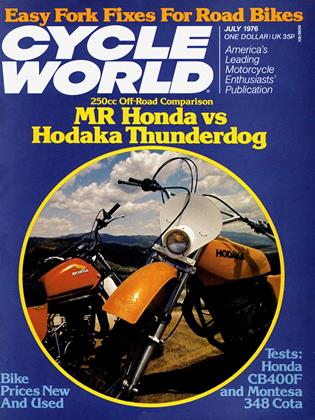Bike Prices New and Used
WHAT'S IT WORTH?
Virginia DeMoss
Ever wonder what you could get for Old Paint if you traded him in on a new motor? Or how much you'd have to pay for a '72 Whatzit on a used bike lot? Well, maybe we can give you some idea. Following is a list of suggested trade-in allowances and retail prices for a selection of motorcycles. This is by no means a complete listing, but rather a sampling of some of the most popular models. Prices were obtained from the Motorcycle Blue Book, published by Hap Jones, P.O. Box 3068, San Francisco, CA 94119. You can obtain a copy for $3.
I-~igures in ttie booK are compilea trom tile actual sales records of the major motorcycle dealers throughout the United States who comprise the Motorcycle Blue Book Advisory Board. Remember, these prices should be used only as a guide. Prices may fluctuate in various localities or because of changing market demands. Retail prices do not include state and local taxes or other fringe charges a dealer might apply to the price of a bike. If a motorcycle requires repairs or reconditioning, that cost should be subtracted from the trade-in figure. According to the book's introduction, "Used trade-in prices are based on the low average to give the dealer a full mark-up and allow for the cost of preparing the used motorcycle for the sales floor. Increase the trade-in allowance for a motorcycle in excellent condition, add for accessories and special equipment." Maybe a browse through this list, or through a copy of the Blue Book, will help you decide whether to trade-in, sell your bike yourself, or hang on for another year.
Primarily as an object of curiosity, we are including the following list showing what various models have cost new each year for the past five. Prices were obtained through telephone conversations with manufacturers and dealers, and reflect the cost of a motorcycle P.O.E. West Coast. It takes only a swift glance over the numbers to determine the trend. . .up. European bikes, according to the figures shown here, haven’t experienced quite the incline of the Japanese marques, but some of them did show rather substantial increases just prior to our survey period. And, as you can see, now is the time to get a good buy on an English motorcycle. . .if you’re able to track one down, or find parts for it a week from now.
But the British aren’t the only ones offering bargains. The fact is that most manufacturers read the market a bit too optimistically after the post-energy-crisis bike boom. But instead of the usual 25to 30-percent growth in the industry last year, many of them got a 25-percent drop in sales. Although sales are likely to pick up this year, most companies are now saddled with large inventories of unsold bikes that they’re going to have to sell cheaper if they’re going to sell them at all. Honda has already begun by offering rebates to buyers; Yamaha has drastically cut prices on some models.
What, then, is the future of the sport? It’s difficult to say. Some take a bleak view, tending to believe that motorcycling will, or already has, become a rich man’s sport. What with looming environmental rulings that will cost manufacturers heavily to cut down noise and exhaust emissions, and the unavoidable fact that the major motorcycle market—the teenage population—is shrinking year by year, not to mention the general nasty state of the economy, the price spiral can only continue. When motorcycle prices start competing with those of cars, which will win?
But then there are those who have judged the situation more calmly. No industry continues 25to 3 0-percent growth indefinitely; motorcycling has reached maturity and should begin trimming its production to realistic levels. Sales, they contend, will continue at an unspectacular yet steady rate.
Then, too, we may all be underestimating the spirit of the sport itself. What rider who does it for the sheer pleasure is going to change his two-wheeler for a car just because of comparable costs? And what’s the dedicated dirt biker to do on weekends, cruise the local strip in his customized car instead of enjoying the desert or a nearby MX track? What’s more, for sheer operating economy in a world of shrinking resources, what can beat a bike?
Yes, bike prices are up. But the same five-year span that we’ve measured here has seen increases of at least 25 to 50 percent in nearly all entertainment industries. . .which motorcycling must be considered too, afterall. Everything—books, records, movies, concerts, airline travel, sporting goods and garb, vans, even your favorite beer or soft drink—has risen by one-quarter, one-half or more. And yet, spokesmen from each of these areas have informed me that business is booming. As a book store proprietor told me while he tended to a line of paying customers, “When it comes to their entertainment, people are willing to pay for it.” It looks as though there’s a bit of that in the offing for motorcyclists; but then they always were a hearty breed.

















